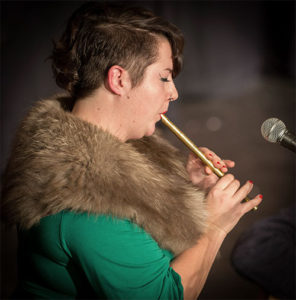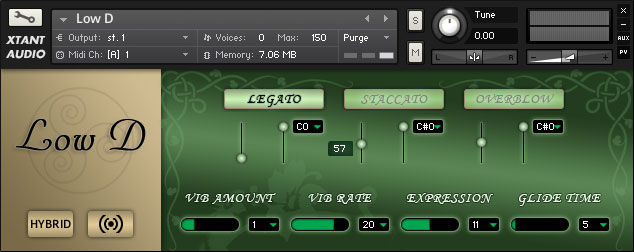This product is no longer available to purchase. A new and improved version is available from Libre Wave.
Tin whistle, penny whistle, English flageolet, tin flageolet, Belfast Hornpipe, feadóg stáin, and of course Irish whistle are just some of the many names given to the traditional Celtic fipple flutes.
The professional edition of O’Malley’s Irish Whistles includes the following whistles: D, C, Bb, Low D, and a bonus patch featuring breath noises and finger taps. This library was recorded in the same studio as Dicky Deegan’s Uilleann Pipes, Michaela’s Harp, and Paddy’s Irish Percussion.
Musician – Irish Whistle
 Mimi O’Malley is a multi-instrumentalist singer-songwriter. She has toured internationally with various bands, playing many styles and genres in a wide variety of ensembles.
Mimi O’Malley is a multi-instrumentalist singer-songwriter. She has toured internationally with various bands, playing many styles and genres in a wide variety of ensembles.
After many years of playing Irish whistle in pubs and working through her clarinet and saxophone grades she gained a place at Chethams School of Music where she studied under James Muirhead (Halle Orchestra) and Joanna Patton (Liverpool Philharmonic).
She continues to travel and perform in ven
ues small and large and is currently working on a solo album.
Live Performance
Here is a live performance of Ships a Sailing, recorded during the sampling session.
Main Interface
With the exception of the breaths and finger taps all of the instruments in this library use the same interface. The on-screen controls provide access to articulations, key switch and continuous controller (CC) customisation, round robin settings, and articulation stacking.
Articulations
All four whistles in this library include legato and staccato articulations, the low D whistle also includes an overblown staccato sample set. The articulation buttons are used to select the articulation you need, they also indicate which articulations are currently active.
You can have more than one articulation active at a time; just hold the control key down on your computer keyboard and click on two or more articulation buttons. You can also control these buttons using key switches.
Smart Legato
Although the Irish whistle is a monophonic instrument it is sometimes desirable in the virtual world to be able to play more than one note at a time.
Traditionally most virtual instruments that include a legato articulation are either monophonic or offer a separate sustain articulation for playing polyphonically. We decided that this was unnecessary and our smart legato is able to detect when a chord is being played and switch seamlessly from legato to sustain mode without needing you to trigger a key switch or click a button.
Trills, Taps, Cuts, and Rolls
Our advanced legato scripting allows you to perform a variety of common whistle ornaments live using your MIDI keyboard. While holding down one key you can press and release another to create realistic trills of any size, tempo, and duration. The same technique can also be used to create other ornaments such as taps, cuts, and rolls.
Stacked Articulations
 All active articulations will be triggered when a note is played. The velocity range sliders on the interface allow you to specify velocity trigger ranges for each articulation. Articulations will only be triggered when the played note is within the specified range – the velocity ranges only apply when more than one articulation is selected.
All active articulations will be triggered when a note is played. The velocity range sliders on the interface allow you to specify velocity trigger ranges for each articulation. Articulations will only be triggered when the played note is within the specified range – the velocity ranges only apply when more than one articulation is selected.
If both legato and a staccato articulation are active at the same time the staccato sample will only be triggered on the first note of each legato phrase. The staccato sample will crossfade into the sustaining sample so that there is a realistic transition between the two. This allows you to play just the staccato notes by releasing the key earlier or play sustained notes with an enhanced attack by holding the note past the initial staccato sample.
Slides and Same Note Legato
 Sliding in and out of notes is a great way to add emotion to a whistle part. You can perform simple slides using pitch bend or create formant correct slides of up to one whole tone by enabling the slide button. This button can be enabled by clicking it, triggering a keyswitch, or using a sustain pedal (CC#64).
Sliding in and out of notes is a great way to add emotion to a whistle part. You can perform simple slides using pitch bend or create formant correct slides of up to one whole tone by enabling the slide button. This button can be enabled by clicking it, triggering a keyswitch, or using a sustain pedal (CC#64).
To perform a slide play a note and while continuing to hold that note play the second note of the slide. With the slide button active this will result in a perfect slide between the two notes.
The duration of the slide is set by the glide time fader. With this fader at its lowest setting the slide time will be determined by the velocity that the second note of the slide is played at; a lower velocity provides a longer slide. In this mode you’ll see the fader briefly jump up to the calculated time when you perform a slide. Setting the fader to any other position disables the velocity control and the length of the slide will be determined purely by the position of the fader. The closer the fader is to the right the longer the slide will be.
This button can also be used to trigger a same note legato transition. When it is active any note played (except the first note of a slide) will sound continuously until the button is turned off. If you play the same note again, with the button is still active, it will trigger a quick legato transition between the two notes.
Round Robin Mode
 Clicking the round robin mode button multiple times will move through the different options. You can also switch between round robin modes using a key switch.
Clicking the round robin mode button multiple times will move through the different options. You can also switch between round robin modes using a key switch.
O’Malley’s Irish Whistles offers four round robin modes:
- OFF – The round robin functionality is disabled
- SIM – A simulated round robin, created by triggering samples adjacent to the played note and retuning them to that note’s pitch.
- GROUP – Also known as true round robin. This mode uses multiple recordings of the same note.
- HYBRID – This mode offers a mix of simulated and group round robins to give you the maximum number of variations.
Keyboard Layout
Playable Range
The playable range of each instrument in O’Malley’s Irish Whistles are coloured blue on Kontakt’s on-screen keyboard.
Articulation Key Switches
Articulation key switches are coloured red on Kontakt’s on-screen keyboard by default. They will turn black on white keys and white on black keys when the articulation they control is active.
You can set which MIDI note is assigned to an articulation as a key switch using the drop down menu next to the articulation’s velocity range sliders. Each key switch must be unique and the instrument will prevent you from accidently applying the same key switch to more than one articulation.
You can also assign articulation key switches by holding the ALT key on your computer keyboard, clicking on the articulation’s button, and then pressing a key on your MIDI keyboard or clicking one on Kontak’s on-screen keyboard.
Function Key Switches
There are two function key switches that appear green on Kontakt’s on-screen keyboard. One of these can be used to change the round robin mode and the other is used to toggle the slide and same note legato button. The keys used to perform these actions is up to you as they are entirely customisable.
To assign the key switch for one of these buttons hold ALT on you computer keyboard and click one of the buttons. Then press a key on your MIDI keyboard or click one on Kontakt’s on-screen keyboard.
When the corresponding button is active these key switches will appear a light blue colour on Kontakt’s on-screen keyboard.
Continuous Controllers
O’Malley’s Irish Whistles has a number of dynamic parameters that can be controlled by a continuous controller. These are:
- Vib Amount – Controls the amount of vibrato
- Vib Rate – This sets the speed of the vibrato
- Expression – Controls the volume and timbre of the whistles. Irish whistles don’t have much natural dynamic control so we have configured this parameter to have an increased volume range allowing you to go – from silence up to the volume that the samples were recorded at.
- Glide Time – This is used to set the length of glides between notes when using the instrument’s glide feature.
The CC number that controls each parameter can be chosen from the drop down menu next to the parameter’s slider. You can use the same CC number to control multiple parameters.
Pitch Bend
All of the whistles in this library respond to the pitch bend controller. This is a great way to play simple slides into and out of notes in real-time.
Sustain Pedal
A sustain pedal (CC64) can be used to turn the slide and same note legato button on and off.
Acknowledgments
Musician: Mimi O’Malley
Recording Technician: Sarah McNeill
Sample Editing, GUI Design, and Scripting: David Healey



